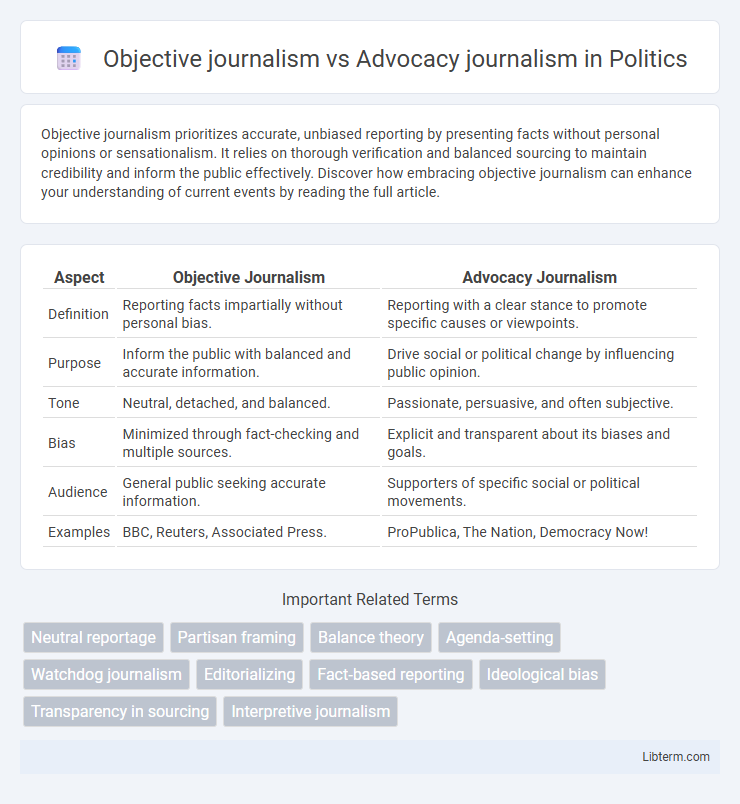Objective journalism prioritizes accurate, unbiased reporting by presenting facts without personal opinions or sensationalism. It relies on thorough verification and balanced sourcing to maintain credibility and inform the public effectively. Discover how embracing objective journalism can enhance your understanding of current events by reading the full article.
Table of Comparison
| Aspect | Objective Journalism | Advocacy Journalism |
|---|---|---|
| Definition | Reporting facts impartially without personal bias. | Reporting with a clear stance to promote specific causes or viewpoints. |
| Purpose | Inform the public with balanced and accurate information. | Drive social or political change by influencing public opinion. |
| Tone | Neutral, detached, and balanced. | Passionate, persuasive, and often subjective. |
| Bias | Minimized through fact-checking and multiple sources. | Explicit and transparent about its biases and goals. |
| Audience | General public seeking accurate information. | Supporters of specific social or political movements. |
| Examples | BBC, Reuters, Associated Press. | ProPublica, The Nation, Democracy Now! |
Understanding Objective Journalism
Objective journalism emphasizes impartial reporting based on verifiable facts, promoting accuracy and fairness without personal bias. It relies on multiple sources and transparent methods to ensure balanced coverage that informs rather than persuades the audience. Understanding objective journalism is crucial for discerning readers who seek trustworthy news amidst growing misinformation.
Defining Advocacy Journalism
Advocacy journalism explicitly supports a specific political or social cause, aiming to influence public opinion and promote change through subjective storytelling and selective reporting. Unlike objective journalism, which prioritizes impartiality, fairness, and presenting multiple viewpoints, advocacy journalism embraces bias to highlight underrepresented perspectives and champion marginalized voices. This approach often incorporates emotional appeals and activist language to engage audiences and mobilize action.
Key Differences Between Objective and Advocacy Journalism
Objective journalism emphasizes impartiality, fact-based reporting, and balanced perspectives to inform the audience without bias. Advocacy journalism openly supports specific causes or viewpoints, aiming to persuade readers and promote social change through opinionated content. While objective journalism seeks neutrality, advocacy journalism prioritizes activism and engagement, often blending facts with commentary to influence public opinion.
Historical Evolution of Journalism Ethics
Objective journalism originated in the early 20th century as a commitment to unbiased reporting, emphasizing accuracy, fairness, and separation of factual news from opinion to establish credibility and public trust. Advocacy journalism emerged later, particularly in the mid-20th century, challenging traditional norms by intentionally promoting specific social or political causes, thus raising debates about the ethical boundaries between reporting and activism. The historical evolution of journalism ethics reflects ongoing tensions between maintaining impartiality and addressing social justice, illustrating how ethical standards adapt to changing cultural and political landscapes.
The Role of Objectivity in News Reporting
Objective journalism prioritizes impartiality and fact-based reporting, ensuring news coverage is free from personal bias to maintain public trust and credibility. Advocacy journalism embraces a clear perspective or agenda, aiming to advance social or political causes by highlighting specific viewpoints and issues. The role of objectivity in news reporting remains central to informing audiences accurately, while advocacy journalism challenges traditional neutrality to foster engagement and prompt change.
The Purpose and Principles of Advocacy Journalism
Advocacy journalism aims to promote social change by intentionally supporting specific causes or viewpoints, emphasizing transparency, accountability, and advocacy over neutral reporting. It prioritizes giving voice to marginalized groups and challenging power structures, often blending factual reporting with persuasive narratives to influence public opinion. Unlike objective journalism, which strives for impartiality, advocacy journalism embraces partiality as a means to highlight underrepresented issues and drive reform.
Impacts on Public Opinion and Democracy
Objective journalism delivers fact-based reporting that fosters informed public opinion and supports democratic processes by promoting transparency and accountability. Advocacy journalism actively promotes specific perspectives, which can mobilize civic engagement but also risks polarizing audiences and undermining unbiased discourse. The balance between these journalistic approaches significantly influences the quality of democratic participation and the public's trust in the media.
Challenges and Criticisms of Each Approach
Objective journalism faces challenges in maintaining complete neutrality, often criticized for false balance and underrepresenting marginalized voices. Advocacy journalism is praised for highlighting social issues but faces criticism for potential bias and undermining factual accuracy. Both approaches struggle with balancing ethical accountability and audience trust in an increasingly polarized media landscape.
Case Studies: Objective vs Advocacy Reporting
Case studies in journalism reveal clear distinctions between objective and advocacy reporting through their treatment of facts and perspectives: the Boston Globe's coverage of political campaigns adheres to objective journalism by presenting balanced viewpoints and verifying information from multiple sources, while The Guardian's climate change reports often employ advocacy journalism, emphasizing urgency and policy change with a clear editorial stance. Objective reporting values neutrality and factual accuracy to inform audiences without bias, whereas advocacy journalism prioritizes promoting social or political causes, potentially influencing public opinion. Analysis of these cases highlights how format, language, and source selection shape journalistic ethics and audience trust across media outlets.
The Future of Journalism: Finding a Balanced Path
Objective journalism emphasizes impartial reporting based on verified facts, aiming to minimize personal bias, while advocacy journalism openly supports specific viewpoints or causes to influence public opinion. The future of journalism requires integrating these approaches to maintain credibility and engage audiences effectively, leveraging digital tools and data analytics to enhance transparency and accountability. Striking a balanced path involves fostering media literacy among readers and adopting ethical frameworks that prioritize truth without sacrificing passion or perspective.
Objective journalism Infographic

 libterm.com
libterm.com